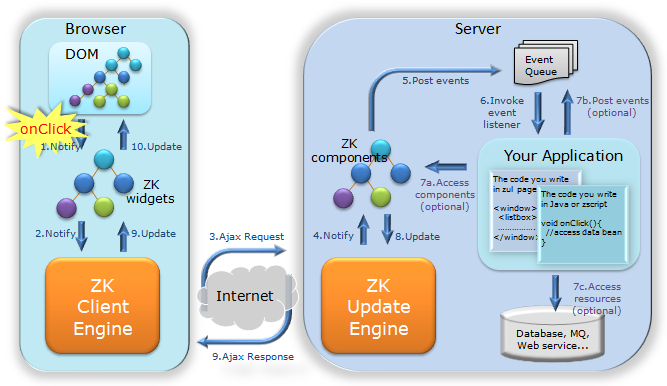Architecture Overview
Application Developer's Perspective
A ZK application runs at the server. It could access the backend resources, assemble UI with components, listen to user's activity, and then manipulate components to update UI. All are done at the server. The synchronization of the states of the components between the browser and the server is done automatically by ZK, and transparent to the application.
When running at the server, the application can access the full stack of Java technology. User activities are, including Ajax and Server Push, abstracted to event objects. UI are composed by POJO-like components. It is the most productive approach to develop a modern Web application.
With ZK's Server+client Fusion architecture, your application won't stop at the server. The application could enhance the interactivity by adding optional client-side functionality, such as client-side event handling, visual effect customizing, and even UI composing without the server-side code. ZK enables the seamless fusion ranging from pure server-centric, to pure client-centric. You could have the best of two worlds: productivity and flexibility.
Component Developer's Perspective
Each UI object in ZK consists of a component and a widget. A component is a Java object running at the server which represents a UI object which can be manipulated by a Java application. A component has all the behavior of a UI object except it has no visual part. A widget is a JavaScript object[1] running at the client. This object represents the UI object which interacts with the user. Therefore, a widget usually has a visual appearance, and handles events happening at the client.
The relationship between a component and a widget is one-to-one. However, if a component is not attached to a page, it won't have the corresponding widget at the client. On the other hand, the application is allowed to instantiate widgets at the client directly without the corresponding component.
How to synchronize the states and distribute the load is really up to the component. ZK Client Engine and Update Engine work together to provide an elegant and robust channel to simplify the implementation.
For example, assume we want to implement a component that allows a user to click on a DOM element to show some detailed information of a component. There are at least two approaches to implement it. First, we could load the detailed information to the client when the widget is instantiated, and then show the detail with pure-client code. Alternatively, we might prefer not to load the detailed information at the beginning, and then send a request back to the server for fulfilling the detail when the user clicks on it.
Obviously, the first approach requires more bandwidth for the initial request but responses faster when users click on it. However, it is generally transparent to the application developers, and the implementation of a component can be enhanced later as the project goes.
- ↑ It depends on the client. For Ajax-enabled browsers, it is a JavaScript object. For ZK Reach for Android, it is a Java object running on an Android device.
Version History
Last Update : 2010/11/2
| Version | Date | Content |
|---|---|---|
